Clematis Blue Angel - a detailed description of the variety
Clematis Blue Angel was bred in Poland in 1988. It is a late-flowering large-flowered hybrid with slender flexible vines reaching a length of 4 meters. The variety is decorative, blooms for a long time (from July to the end of September), but it often gets sick and needs scrupulous care.
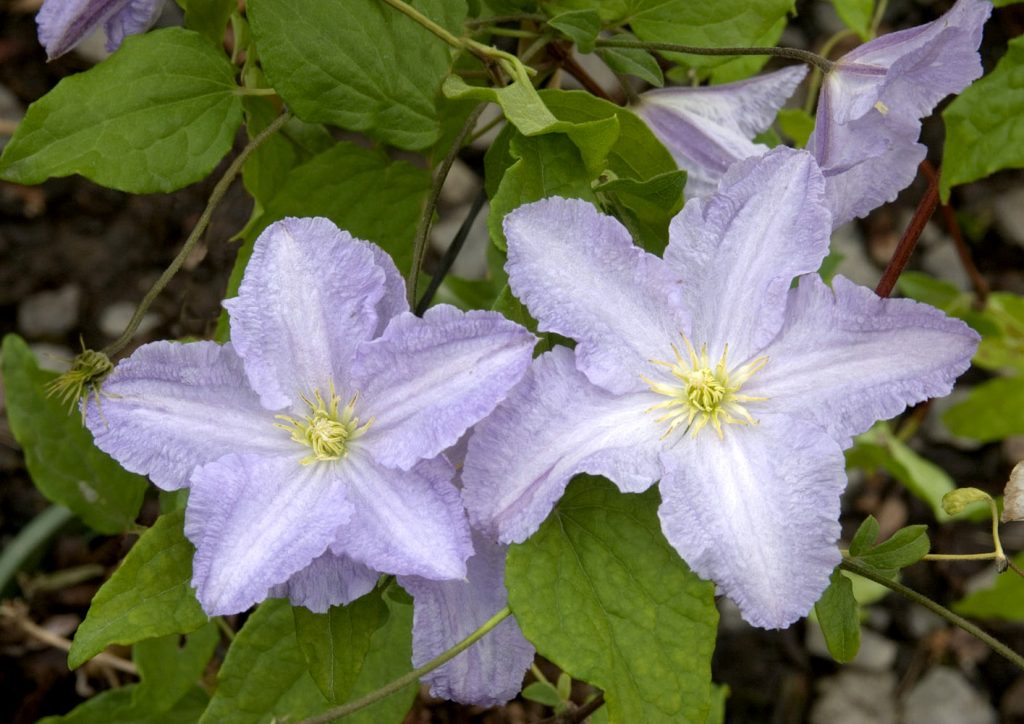
Clematis blue angel description
Description of the variety
This clematis differs from others in its rapid growth and length of shoots. Flexible. Thin vines reach over 4 meters in length. After pruning, they grow back rapidly, launching many side shoots. The leaves are trifoliate, dark green, with a glossy sheen.
The flowers are light blue, delicate, large. The name of the variety suits him. The buds really, with their tenderness and fragrance, resemble angels, they are so beautiful and pure. The diameter of each flower is up to 15 cm, a lot of them bloom on the bush. It immediately takes the form of an air cloud, which smells fragrant from July to mid-autumn.
Unlike other varieties, the Blue Angel produces buds only once a year, later than the others, but the flowering is longer. With good care and other favorable conditions, this clematis can remain in bloom for three months or more. The only disadvantage of the variety is its susceptibility to various diseases, weak immunity.
Landing features
Clematis (clematis) can be planted outdoors in both spring and autumn. However, pre-winter planting is preferable, because after it the plant takes root more easily, before frost it has time to adapt, to increase the root mass. Since spring, the bush immediately grows and may even bloom in the same year, which never happens with a spring planting.
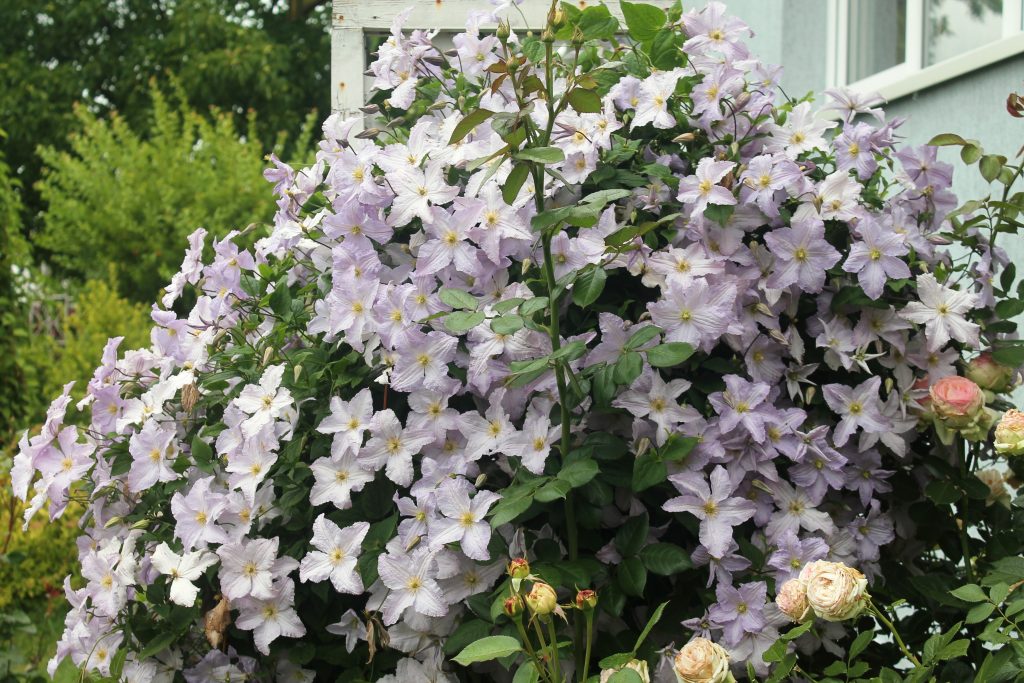
Clematis blue angel
Seat selection
The Blue Angel is a warm and light-loving variety. A slightly shaded place on a hill in the southern or southeastern side of the site is suitable for him. The lowland for clematis is not suitable, its roots are too afraid of waterlogging. If groundwater is close to the surface, then such a place is also not the best option for clematis.
The planting pit is prepared in 2-3 months. If you are planning an autumn planting, then you need to decide on the place in July. The size of the pit is 60x60, regardless of the size of the bush. Even a small seedling needs to prepare a full-fledged planting pit with drainage and properly selected soil.
The roots of all clematis are highly branched and grow rapidly. The Blue Angel variety is no exception. Already in the first year, the entire prepared pit will be filled with the root ball of the plant. Therefore, it will be difficult to overdo it with its size. The main thing is to make good multilayer drainage at the bottom. Without it, moisture will stagnate at the roots of the bush, and this is dangerous for the hybrid.
Preparation of planting material
If a seedling was bought in a nursery, then they probably took care of its health. Such planting material does not need additional preparation.It can be immediately transferred to the planting hole and placed in the ground. Just in case, before planting, you can dip the roots in Ecosil's solution - this will provoke the growth of peripheral roots.
Seedlings purchased in online stores or on the market should be given special attention. Often, you come across unscrupulous sellers who supply deliberately low-quality planting material. If the seedling is withered, leaves with spots, yellowed areas, twisted or even fallen, the stems are uneven, with growths - such seedlings cannot be treated. They just need to be destroyed.
The roots of the plant are also worth examining when buying. The lump should not be waterlogged or dry. If you lightly run your fingernail along a healthy root, its snow-white dense pulp is visible. At rotten roots, the entire inner part is black, sluggish, they easily come off.
Important! You should never buy and plant flowering seedlings. They won't take root.
Landing technology
Nutrient soil is poured into the pit with drainage. Its composition depends on the type of soil. If it is acidic, add lime or dolomite flour in a ratio of 7: 1. Clay soil is diluted with sand, peat, leaf turf. Only the sand should be coarse, fine construction will make the earth even heavier.
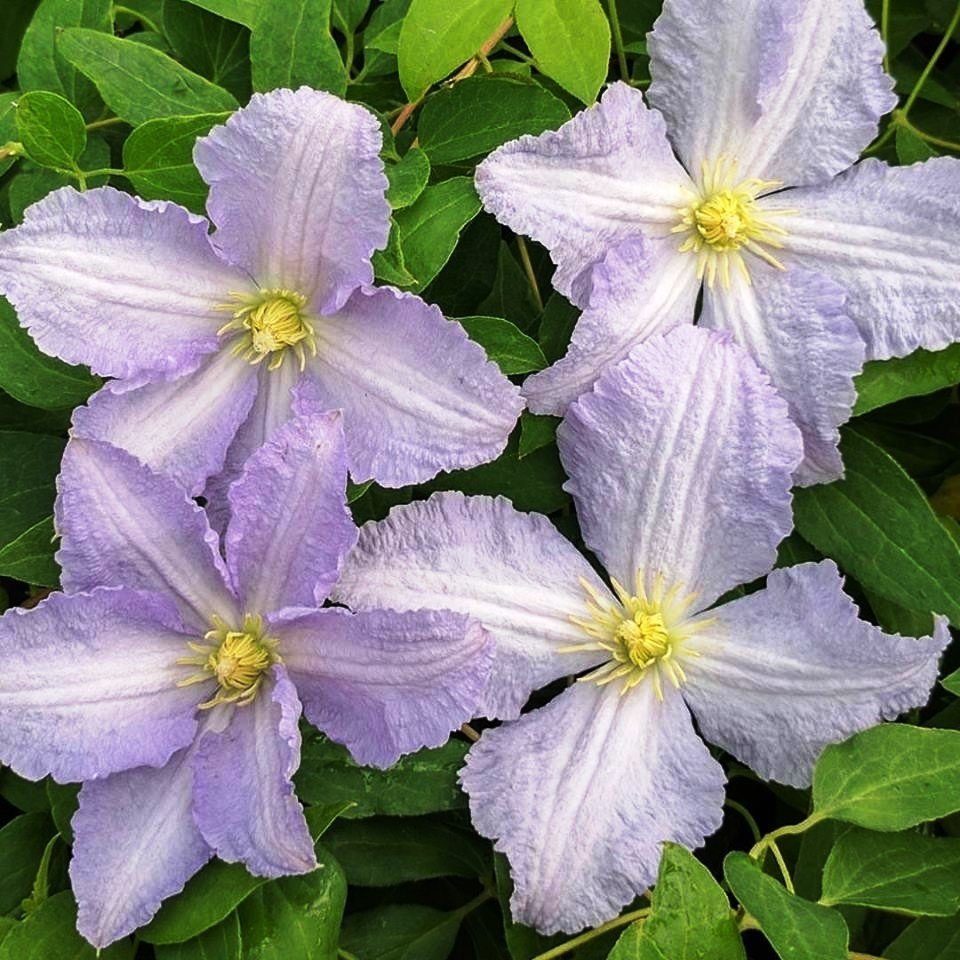
Clematis blue angel reviews
Sandy soils are poor in useful microelements. Before planting clematis, humus, compost, clay are added there. Peat soil is supplemented with humus or universal purchased nutrient soil. Before planting clematis, it is advisable to calcine the soil in an oven for disinfection. Then pour into the hole, form a small mound.
A seedling is placed on top of an earthen hill, the roots are straightened. The support is placed next to it, in the same hole, so as not to injure the roots of the bush later. All this is covered with earth from above and slightly compacted. The root collar of clematis should be completely hidden under the soil layer. Above, the layer of earth should be at least 15 cm. Then the seedling will take root normally and begin to grow.
Care
The Blue Angel is a rather demanding hybrid. The grower will have to carefully study the preferences of this variety in order to satisfy all his needs. But with a favorable outcome, the plant will delight with long and lush flowering for more than one year in a row.
Watering
All large-flowered varieties love moisture, their powerful roots pull it out of the ground like pumps. Therefore, it is impossible to overdry the bush, especially during the active period. When organizing good drainage, it is even better to water it more often than it should be. Drainage will not allow moisture to stagnate at the roots, they will not rot, and clematis will not suffer from a lack of fluid.
Spring clematis is watered twice a week. It is better to use rainwater, previously collected. Daily watering is allowed in hot summer months. It is better to water the bush in the evening, when it is already getting dark. At this time, the plant does not spend energy on photosynthesis, but completely focuses on the assimilation of nutrients from the soil.
Mulching and loosening
Clematis roots are breathable and require loose, light soil. To improve air permeability, the ground under the bush must be periodically loosened. This is usually done after every watering or rain. The main thing is not to damage the small roots that are close to the surface during the loosening process. The plant reacts painfully to any damage to the roots.
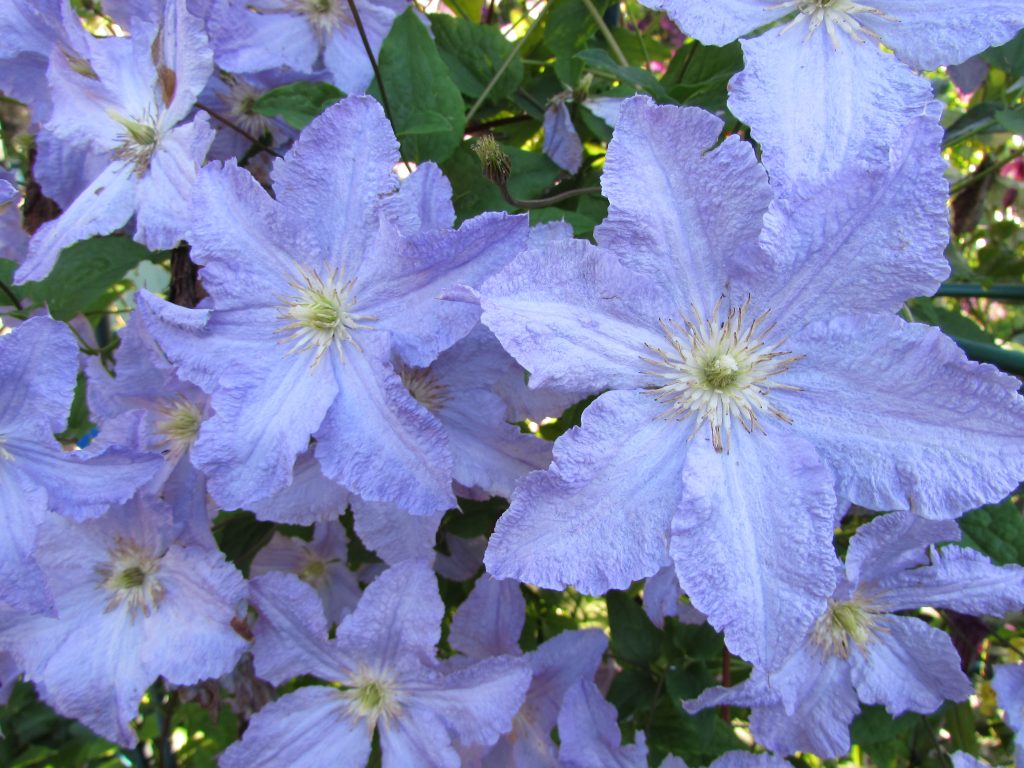
Clematis blue angel
Mulching the soil around the bush is necessary to protect the roots from overheating, to retain moisture. Sawdust, humus, dry hay or chopped pieces of wood are used as mulch. Orchid substrate works well, but it is an expensive "treat".
Mulching is sometimes replaced by planting low-growing annuals under clematis. Marigolds and calendula are wonderful "neighbors" for them. They have small roots, retain moisture well in the soil and repel flying and crawling pests.In autumn, they rot and fertilize the soil, supplying the necessary minerals to the roots of clematis.
Top dressing
Fertilizing clematis should be based on the season. The plant requires different nutrients at different times. In spring, clematis needs nitrogen. This element provokes the growth of green mass, awakens from winter sleep, forces the plant to actively release new shoots.
Before starting budding, you need to make top dressing with a high content of phosphorus. Superphosphate and potassium phosphate are the main drugs during this period. A solution of urea is used for spraying foliage - this is a powerful foliar dressing.
Before blooming and during flowering, potassium fertilizers are applied under the bush - sylvinite and potassium sulfate. Wood ash solution is also a good source of potassium. Ash can be mixed with the topsoil. The main thing is that it should be just woody. And not after burning household waste, plastic and other materials.
In autumn, clematis is fertilized with manure. It should be a rotted mullein, dry, easily crumbling into small pieces. You cannot feed the flower with fresh manure or droppings - the root system will be burnt. Before freezing, feeding is stopped, the plant goes to sleep. The only thing that is introduced into the soil at this time is fungicides for soil disinfection.
Pruning
The Anna German variety belongs to the III pruning group. This means that before wintering, all shoots are cut off entirely, leaving only a part of the trunk with 3-4 buds. Clematis trimmings are of three types: initial, sanitary, basic.
Initial. Needed immediately after landing. Only 3 kidneys are left below, the rest is removed. This is necessary so that the plant does not waste energy on forcing shoots and leaves, but forms a strong root system.
Sanitary. Falls out in the middle of summer. Remove dry, diseased, damaged branches. The bush is thinned out for better air circulation and uniform illumination of all flower buds. Pruned bushes are more luxuriant and bloom longer, have a neater, decorative look.
The main one. Required in the fall, according to the group to which the variety belongs. The Blue Angel, belonging to the III pruning group, requires complete removal of shoots in the fall. Above the ground, a section of the trunk is left 15-20 cm high. After the snow melts, the buds come to life, and the plant grows.
Preparing for winter
The variety is quite winter hardy, but prone to all kinds of rot. Therefore, during wintering, it is not so much the cold that is terrible for him as waterlogging of the roots. You need to mulch the soil only with dry peat or hay, which are laid out in the trunk circle. The cut stump remains on the surface.
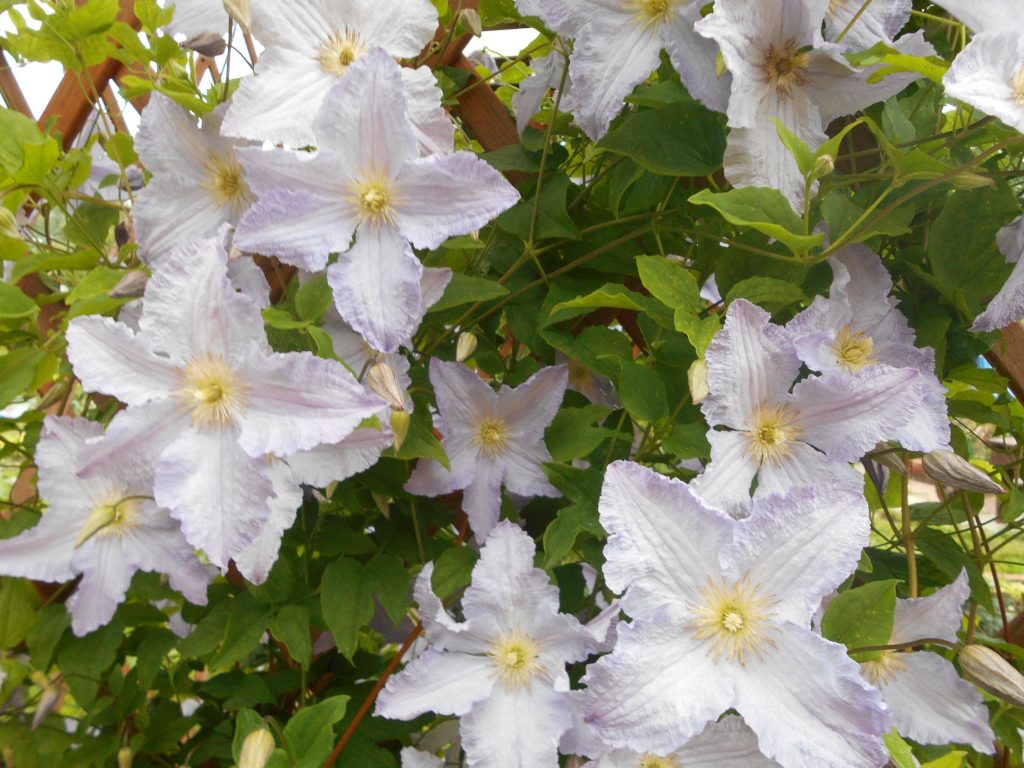
Clematis blue angel photo
Then the bush is covered with spruce branches, polystyrene, dry oak foliage, and a non-woven cloth is placed on top. The covering material should allow air to pass through well, not allowing the roots to rot. It is reused every year if the plant hibernates under it.
Important! You cannot cover the Blue Angel variety with sawdust for the winter! They get wet, freeze and then slowly thaw, causing inconvenience to the plant and leading to its diseases and even sometimes to death.
Reproduction
The Blue Angel is a hybrid variety, so it makes sense to propagate it only in vegetative ways. The seeds do not retain varietal properties. Moreover, this method is laborious and time consuming. A full-fledged bush from seeds can really be obtained only after 3-4 years.
Cuttings
Cuttings are conveniently prepared during autumn pruning, but then they will have to be kept alive until spring, which is very problematic. It is better to cut them in the spring, in May, when each shoot contains at least 5-6 live buds. From each shoot, take the middle, from which cuttings are cut.
They can be easily rooted in water or substrate. The first option is the fastest, but then when transplanted into the ground, the delicate roots of the cutting are damaged. He may die. In the substrate, rooting takes longer, but more reliable.If the stalk already grows, it will not die and with a probability of 99% will live to be transplanted into an open area in the garden.
The substrate should be lightweight and breathable. Perlite and vermiculite, light garden soil and coarse sand - all mix and arrange in flowerpots. Place the cuttings there and cover with jars for a greenhouse effect. At a temperature of + 26 ° C, the roots appear quickly - after 1-2 weeks. Then the banks are removed and the seedlings are accustomed to room temperature.
Layers
This is the easiest way to breed this hybrid. In an adult bush, several lower vines are taken to the sides, bent to the ground and buried in. The place of contact with the ground is often watered with warm rainwater. After a month, the layers will take root, but you cannot immediately separate it.
At first, the young seedling feeds on the mother bush. Its roots are still too weak to support full growth and development. Throughout the season, the cuttings are in this dependent state. Some gardeners even leave them for the winter, and only separate them in the spring. So there is a greater chance that the seedlings will take root and continue to grow after separation.
By dividing the bush
The bush is divided not only to propagate it. This is a necessary procedure for rejuvenating the bush. With a long stay in one place, the bush thickens, grows worse and stops blooming. They divide it in two ways: radically and sparingly.
The sparing method is the simplest. With the help of a shovel, part of the bush is chopped off and transplanted to a new place. Several such parts are separated if the bush is too old and overgrown. Each segment is a full-fledged young bush that can bloom the next year.
Radical separation is a more difficult, but in some cases necessary, way to rejuvenate a plant. The bush will have to be dug out in its entirety, the roots, and then the stems, will have to be divided into separate parts. One bush can make a dozen or more independent plants. For them, you need to think about a place in the garden in advance and prepare planting holes.
Diseases and pests
The Blue Angel variety is susceptible to many diseases. The most common among them are:
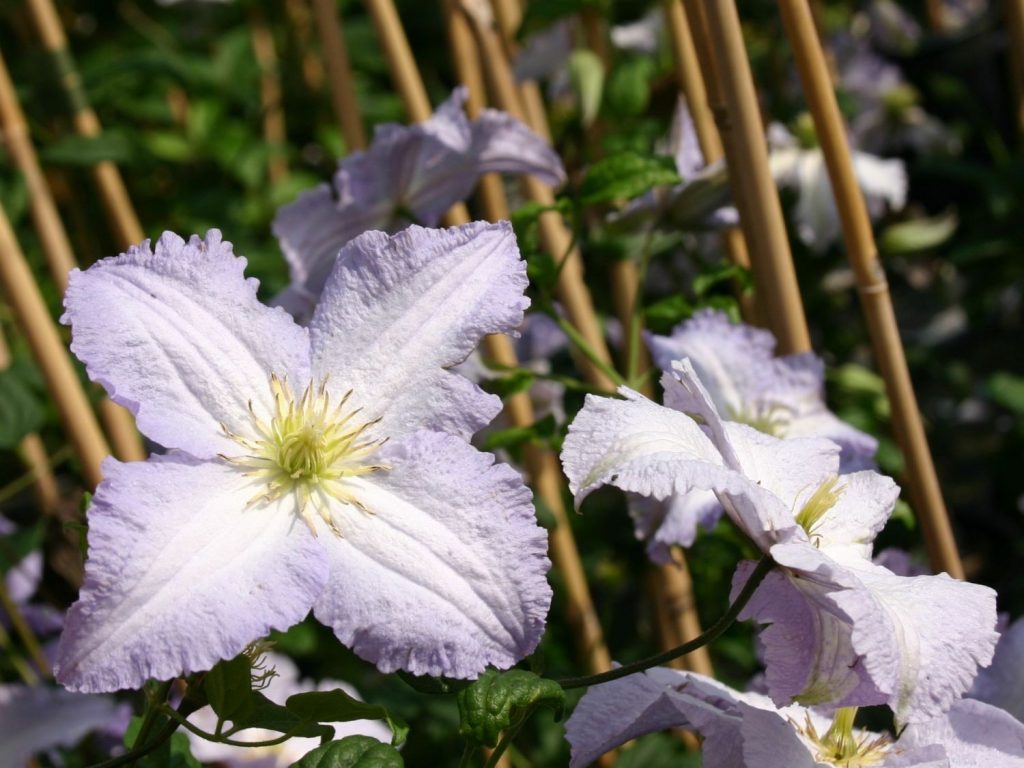
Photo of clematis blue angel
- Withering (wilt). The causative agent is a fungus of the genus Phomopsis or Verticillum. Shoots begin to blacken and wither one by one. The root cause is an excess of nitrogen in the soil with a deficiency of phosphorus and potassium. Treatment - fungicide Switch 0.1% twice in 10-12 days.
- Alternaria. Caused by the fungus Alternaria alternata, which causes mottling and leaf fall in clematis. Treatment - treatment with fungicides Kartotsid, Bordeaux mixture, Cuproxat, Novozir.
- Powdery mildew. It is caused by the pathogenic fungi Erysiphe communis and Leveillula ranunculacearum. Leaves and shoots are covered with a whitish bloom. Treatment - preparations of sulfur and copper, Impact Super, Rubigan, Sistan, HOM.
- Cylindrosporiasis or fungal spot. It is expressed in yellowish-brown spots on the leaves. Treatment - Bordeaux liquid, HOM, Abiga-Peak.
- Ascochitis. Leaves dry, curl and fall off. Treatment - Ridomil Gold, HOM, Abiga-Peak.
Of the pests, nematodes are the most dangerous for clematis. These are microscopic worms that infect the roots of the plant. Nematodes multiply very quickly, 10 generations of pests are replaced during the season. For prevention, it is required to regularly weed the area around the bushes, spray with fungicides at least twice a season. There is no cure for nematodes. The plant will have to be destroyed.
Pests such as spider mites, scale insects, moths, and fenestrated moths are affected by clematis and are easy to spot with regular inspection of the plant. The treatment is the treatment with insecticides Antiklesh, Aktellik, Aktara, Akarin. It is carried out twice in 2-3 weeks in order to destroy pests at different stages of development.
Landscape use
Clematis Blue Angel is very tall, its lashes reach 5 meters, which is convenient to use in decorating various elements of the garden.This variety is better than others for decorating gazebos, building facades and willow hedges. Arches braided with clematis look amazing all season.
You can plant this hybrid together with other climbing plants such as climbing roses, various types of decorative grapes and others. If you choose them by variety, it is easy to achieve constant flowering in the garden from spring to the very frost.
Testimonials
The Blue Angel variety has extremely positive reviews. Despite its weak disease resistance, the variety attracts with decorativeness, long flowering and frost resistance. Ease of pruning and undemanding shelter for the winter are also important advantages of this variety.
Gardeners note the special splendor of flowering. Usually large-flowered clematis cannot "boast" of such a feature. At the same time, for abundant flowering, you do not have to resort to additional manipulations.
Clematis is really an unusual, beautiful and relatively easy-to-care flower. It winters well even in the northern regions with harsh conditions. It is easy to propagate it, and with good disease prevention, the plant will delight with flowering for many years without problems.

